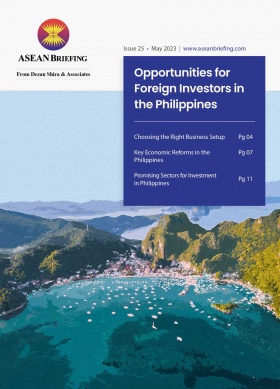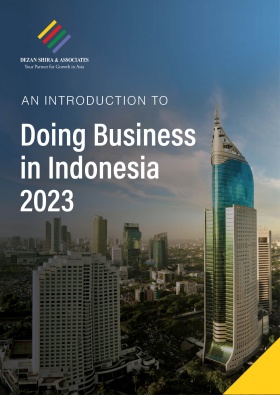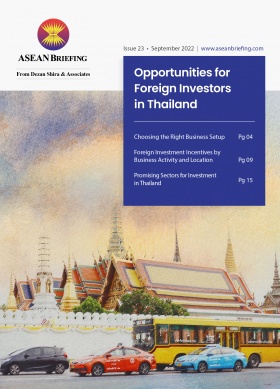Examining Thailand’s Economic Revival and Investment Opportunities
Thailand’s economy is forecasted to grow between 2.7-3.6 percent, buoyed by an influx of foreign tourists, improving domestic consumption, and food exports.
Thailand’s GDP outlook is expected to grow between 2.7-3.6 percent in 2023, an increase from 2.6 percent in 2022. Economic growth will be boosted by a recovering tourism industry and improving private consumption.
Southeast Asia’s second-largest economy was in a severe recession in 2020 due to the pandemic. GDP fell by 6.1 percent in that year, which represented Thailand’s largest contraction since the Asian Financial Crisis.
Despite Thailand continuing to face several challenges this year, ranging from a weaker baht, a contraction in exports due to external risks, and a predicted fall in public consumption, the country offers ample opportunities for foreign investors. Thailand’s strategic geographic location in the center of ASEAN makes the country an important manufacturing and distribution base with direct links to the Chinese and Asian markets.We look at several industries that are showing good growth prospects in 2023.
The tourism sector rebounding
Tourism is an important sector for Thailand. The sector contributes to approximately 20 percent of GDP with a record 39 million international tourists visiting the country in 2019 before the onset of COVID-19. This brought US$64 billion to the economy.
Thailand is particularly eager to recapture the Chinese tourist market after China reopened its borders in early January. The government has targeted five million Chinese tourists this year, who are expected to contribute at least US$13 billion to the economy. Between January and May 2023, Thailand saw 9.47 million international tourists and will look to surpass 11.5 million foreign travelers that entered the country in the whole of 2022 – this figure dwindled to just 427,869 in 2021. Thailand is expected to see 25 million foreign visitors in 2023 and is aiming to generate US$71 billion in revenue.
The Tourism Authority of Thailand expects the industry to return to pre-pandemic levels by 2025 with the country forecasted to receive 40 million international arrivals in 2024.
Exports on the rise
Food exports
Food exports are predicted to gain some 44.3 billion dollars for Thailand this year, an increase of 2.1 percent year-on-year led by increasing global demand from countries recovering from the pandemic, particularly from China.
Thailand is one of the world’s largest net exporters of food and is one of the top 10 producers of many important agricultural products, such as rice, pineapples, cassava, sugar cane, natural rubber, and coconuts. Food exports contribute approximately 23 percent of GDP annually and the country is aiming to reach US$58.6 billion by 2036.
Investment opportunities in Thailand
As the second-largest economy in Southeast Asia behind Indonesia, Thailand presents ample investment opportunities for foreign businesses. The country has experienced growing domestic consumption over the decades coupled with robust export-oriented manufacturing, resulting in the country gaining the status of an upper-middle-income nation in 2011.
Value added manufacturing
Thailand’s economy is dependent on exports, which accounted for some 60 percent of GDP before the pandemic. As such, the country’s manufacturing sector plays an important role, contributing 27 percent of GDP in 2021; the sector’s success or failure often dictates the overall health of the economy.
Over the last 50 years, Thailand has built up a robust manufacturing sector. It is now keen to attract investments for mid/high-tech manufacturing, especially as regional rivals like Vietnam and Cambodia become new centers for low-cost production in the region.
Webinar – Future-Proof Your Business: De-Risking Your Supply Chain in Asia
August 23, 2023 | 9:00 AM PDT / 12:00 PM EDT
In this webinar, a panel of Business Intelligence Leaders will help you understand key differences between the main markets in South / Southeast Asia and discuss their evolving supply chain ecosystems, enabling you to make informed decisions to de-risk your supply chain.
EV manufacturing
The Thai government wants Thailand to evolve into a base for electric vehicle (EV) production. German luxury carmaker, Mercedes, chose Thailand as its first site in Southeast Asia to manufacture its electric EQS model with Toyota as well as Chinese car manufacturer Great Wall Motor signing up for a government incentive plan to produce EVs in Thailand.
The country’s emergence as an EV production hub in the region has been fast-tracked by generous incentives, such as 3-11 years of tax holidays and investment incentives for EV infrastructure.Medical tourism
Thailand earned US$1.8 billion from over four million medical tourists in 2019, which amounted to three percent of the GDP and was projected to reach 3.5 percent until the pandemic struck. The country served clients mainly from the US, the Middle East, and Europe.
Medical treatments can be lower by up to 30 percent compared to the West and the quality of healthcare is comparable to leading hospitals worldwide. The Thai medical tourism industry is projected to have a market value of US$24.4 billion by 2027.
Halal food manufacturing
Despite being a Muslim minority country, Thailand is the 12th largest global exporter of Halal products and the fifth largest producer of Halal foods. Halal food accounts for 20 percent of Thailand’s total food exports, with 60 percent of its Halal food exports going to the Muslim-dominated countries of Indonesia, Malaysia, and Brunei. As such, the country is well-placed to be a hub for Halal F&B manufacturing in the region.
Thailand has met several key strategies in the Halal food industry, such as its increasing capacity in Halal certification and formulation and upgrading its research and development.
New free trade agreements are in the works
Thailand has 14 free trade agreements (FTAs) and the Regional Comprehensive Economic Partnership (RCEP) – the world’s largest free trade agreement – is the latest trade pact to which the country became a signatory.
These FTAs offer investors a competitive benefit when importing components, raw materials, and other industrial inputs from these countries.
Thailand aims to conclude FTAs with the European Union (EU), Sri Lanka, and the United Arab Emirates (UAE) by the middle of 2024 as the country looks to expand market access for its exports as well as attract foreign investment.
An FTA with the UAE would make it the first such agreement with a country from the Middle East. The UAE is currently Thailand’s sixth-largest trading partner and the largest in the Middle East. Furthermore, concluding an FTA with Sri Lanka will offer Thailand access to the South Asia market and create a connection with India, Pakistan, Bangladesh, and Nepal.
About Us
ASEAN Briefing is produced by Dezan Shira & Associates. The firm assists foreign investors throughout Asia and maintains offices throughout ASEAN, including in Singapore, Hanoi, Ho Chi Minh City, and Da Nang in Vietnam, in addition to Jakarta, in Indonesia. We also have partner firms in Malaysia, the Philippines, and Thailand as well as our practices in China and India. Please contact us at asean@dezshira.com or visit our website at www.dezshira.com.
- Previous Article Audit and Compliance in Singapore: A Guide for Foreign Investors
- Next Article An Overview of Goods and Services Tax in Singapore







